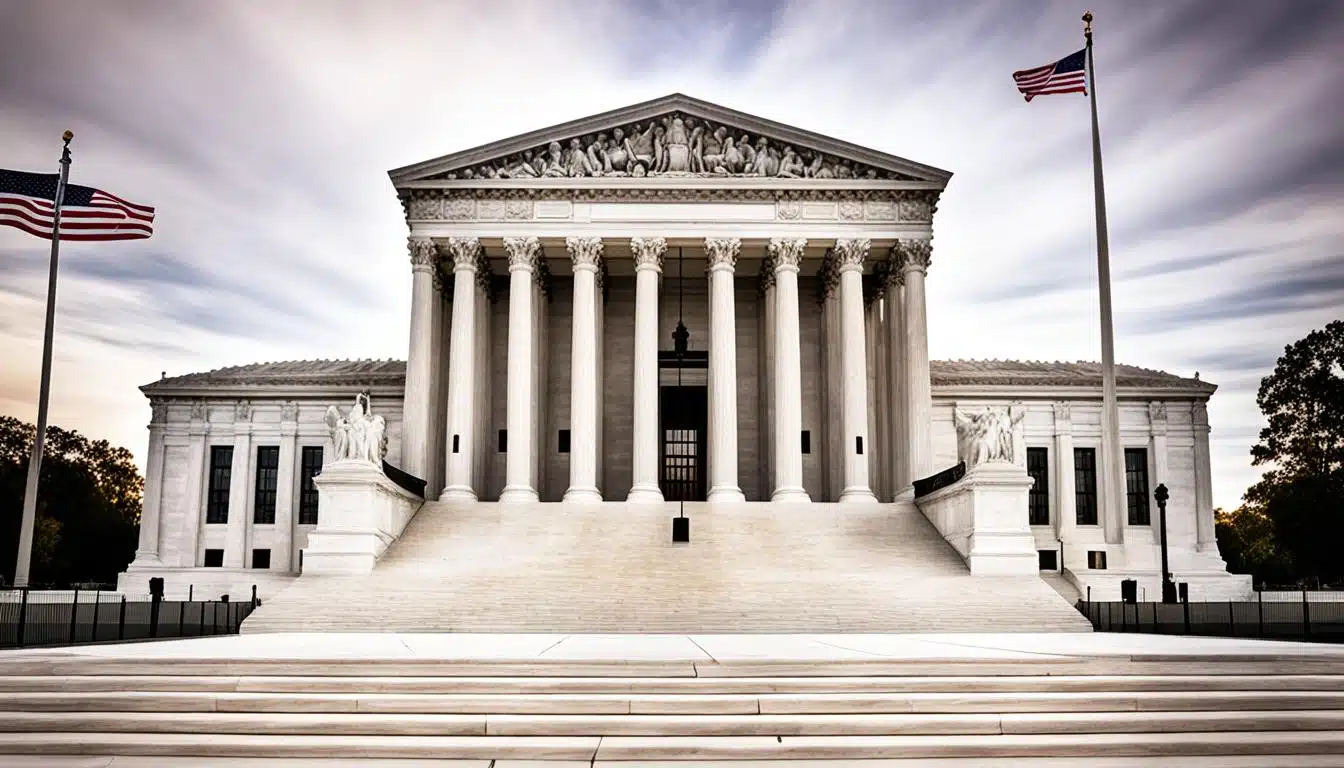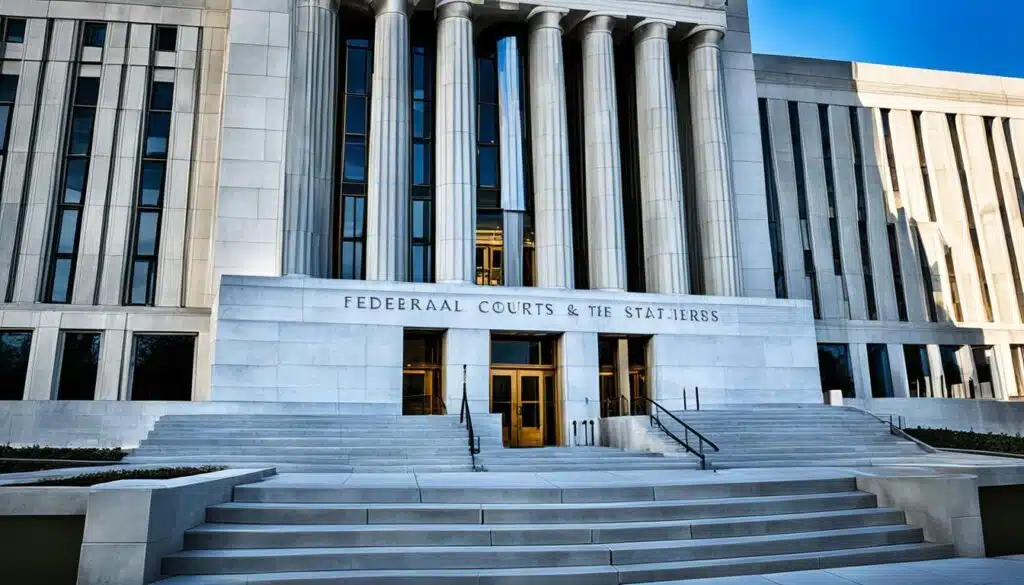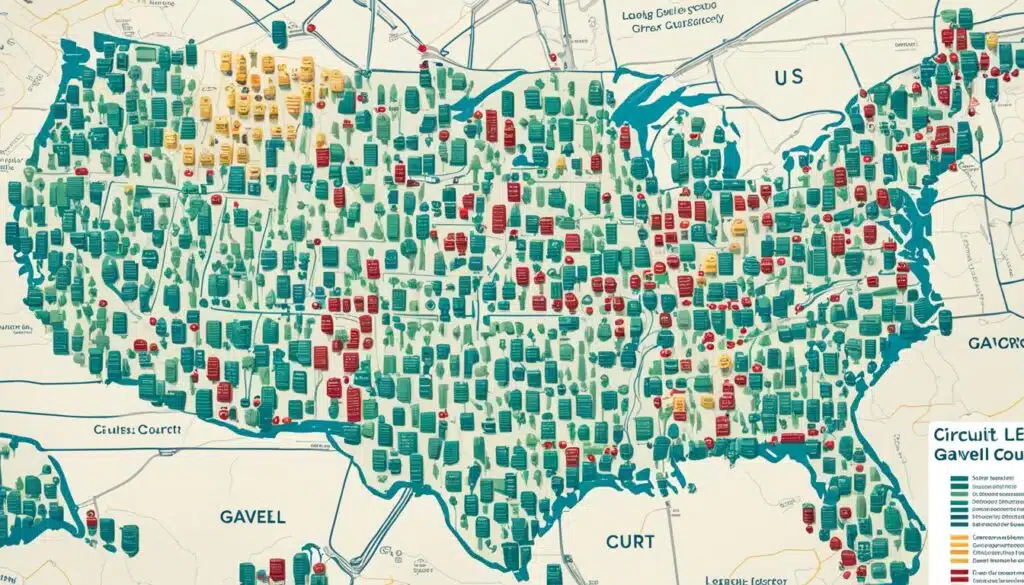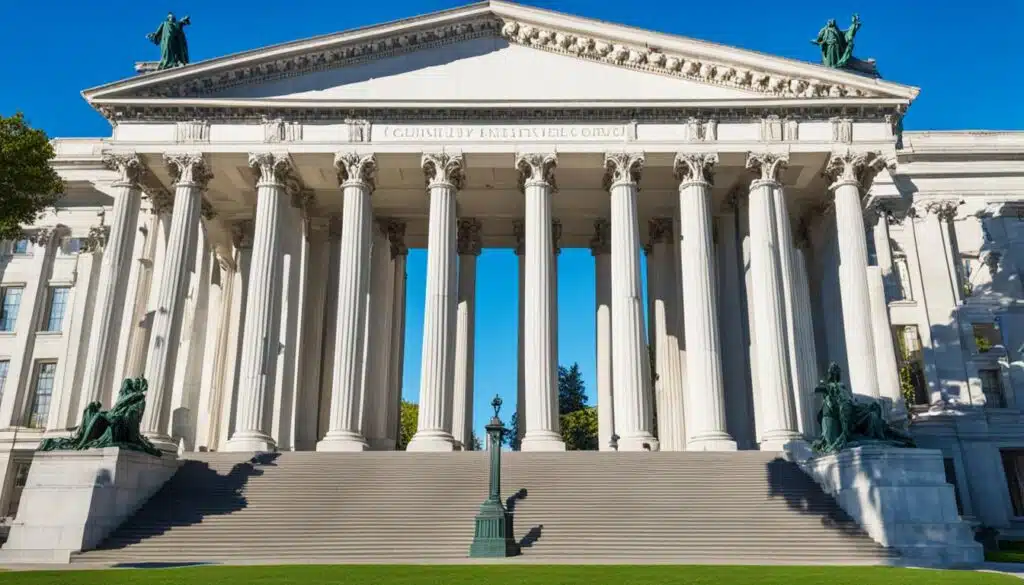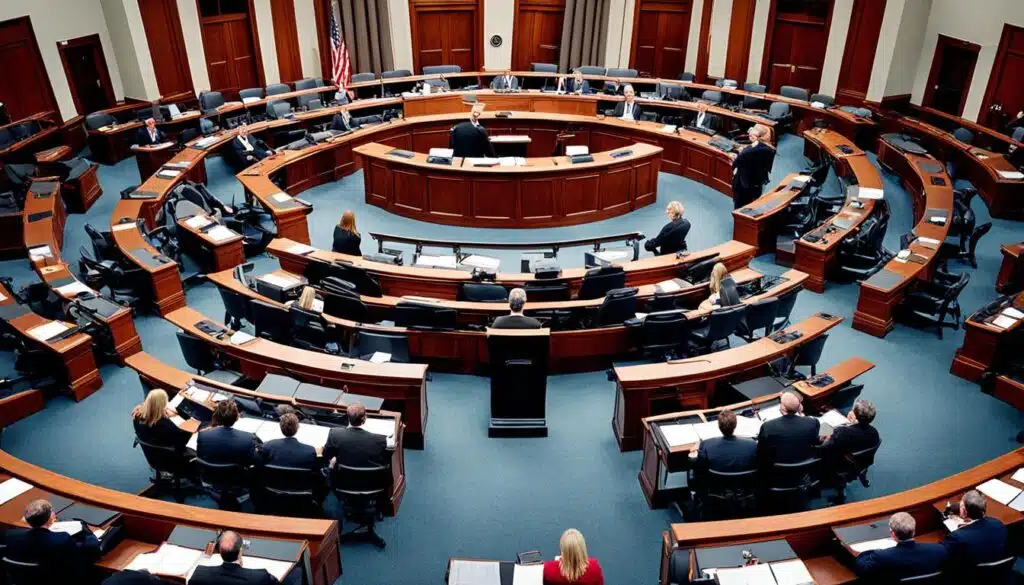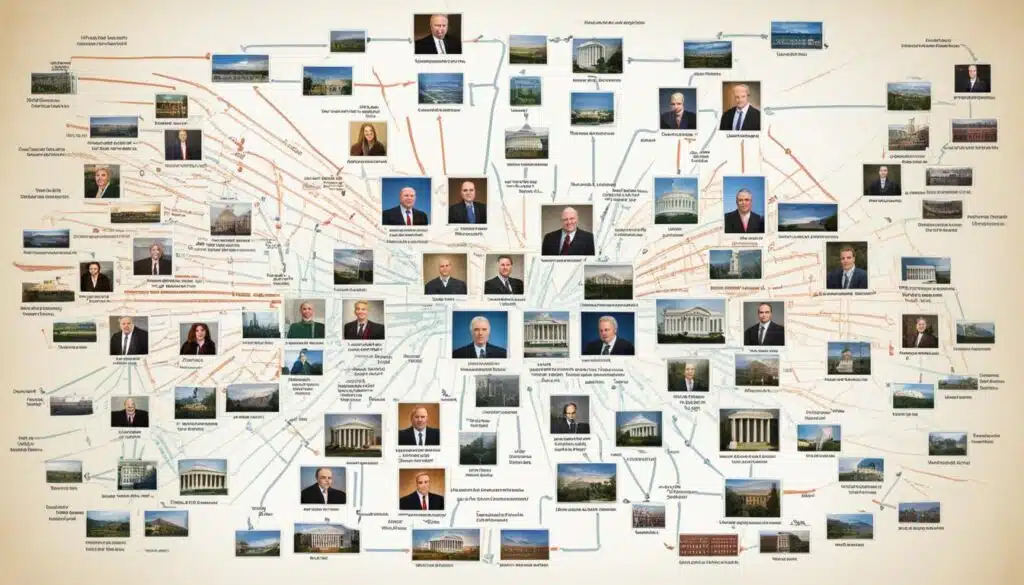The court structure in the US legal system is a complex hierarchy that ensures fair and efficient administration of justice. At the top of this structure is the Supreme Court, the highest appellate court in the country.
Below the Supreme Court are the circuit courts and district courts. Circuit courts serve as the first level of appeal, while district courts function as trial courts at the federal level. These courts play crucial roles in interpreting and applying the law to resolve disputes.
Understanding the court structure is important for navigating the judicial system and upholding the principles of justice. Let’s delve deeper into the different levels of courts and their functions in the US legal system.
Also Read : What Qualifications Are Required To Become A Barrister?
Key Takeaways:
- The US legal system has a hierarchical court structure, with the Supreme Court at the top.
- Circuit courts are the first level of appeal, while district courts serve as trial courts.
- The court structure ensures fair and efficient administration of justice.
- Understanding the court structure is crucial for navigating the judicial system.
- The Supreme Court is the highest appellate court in the US legal system.
The Federal Court System
The federal court system in the United States is a complex structure that consists of district courts, circuit courts, and the Supreme Court. It serves as the backbone of the country’s judicial system, ensuring the fair administration of justice at the federal level.
The District Courts
At the base of the federal court system are the district courts. There are a total of 94 district courts spread across the United States, including territories and the District of Columbia. Each state has at least one district court, while populous states like California and New York have multiple district courts.
The district courts are often referred to as trial courts, where most federal cases begin. They have limited jurisdiction and can only hear cases authorized by the United States Constitution or federal statutes. As a result, district courts primarily handle cases arising under federal law, including civil and criminal matters.
| Key Features | Number | Jurisdiction |
|---|---|---|
| Number of District Courts | 94 | Limited jurisdiction |
| Types of Cases | – Civil and criminal federal cases – Cases authorized by the U.S. Constitution or federal statutes |
Also Read : What Are The Fundamental Principles Underlying Common Law?
The Circuit Courts
Above the district courts are the circuit courts, also known as the courts of appeals. There are 13 circuit courts in the federal court system, with each circuit covering specific geographic areas. The circuit courts primarily handle appeals from the district courts within their respective circuits.
Unlike the district courts, circuit courts do not hold trials or hear evidence. Instead, they review the decisions made by the district courts to determine if any errors were made or if the law was applied correctly. Appeals are typically heard by a panel of three judges, and in some cases, the entire circuit court may hear the appeal en banc, meaning all judges in the circuit participate in the decision-making process.
| Key Features | Number | Jurisdiction |
|---|---|---|
| Number of Circuit Courts | 13 | Appellate jurisdiction |
| Types of Cases | – Appeals from district courts – Reviewing decisions for errors or correct application of the law |
The Supreme Court
At the pinnacle of the federal court system sits the Supreme Court. It is the highest court in the country and has the final say on matters of federal law. The Supreme Court consists of nine justices, including the Chief Justice of the United States.
The Supreme Court’s primary function is to review appeals from lower federal and state courts, ensuring consistency and clarity in the interpretation of federal law. It has the authority to accept or deny requests for a writ of certiorari, which is a petition for the Court to review a lower court’s decision. The Supreme Court’s decisions are binding on all federal and state courts and have a profound impact on the interpretation and application of law across the nation.
| Key Features | Number | Jurisdiction |
|---|---|---|
| Number of Supreme Courts | 1 | Final appellate jurisdiction |
| Types of Cases | – Appeals from lower federal and state courts – Matters of federal law |
Also Read : What Is The Significance Of Statutory Laws In A Legal System?
Differences Between Federal and State Courts
Federal courts and state courts operate differently within the US legal system.
In civil cases, federal courts have limited jurisdiction and can only hear cases authorized by the Constitution or federal statutes. On the other hand, state courts have broader jurisdiction and can hear a wider range of civil cases.
In criminal cases, both federal and state courts have jurisdiction, but they handle different types of cases. Federal courts handle criminal cases involving federal offenses, such as violations of federal laws, while state courts handle criminal cases that involve violations of state laws.
Original jurisdiction is another key distinction between federal and state courts. Federal courts have original jurisdiction over cases arising under federal law, meaning they can hear and decide cases without them going through lower courts first. State courts, on the other hand, generally have original jurisdiction over most civil and criminal cases that do not fall under federal jurisdiction.
Diversity jurisdiction is a unique aspect of the federal court system. It allows state law claims to be brought in federal court when all plaintiffs and defendants are from different states and the amount in controversy is more than $75,000. This provision ensures that parties from different states can have their cases resolved in federal court, providing a neutral venue for dispute resolution.
The decision of whether to file a case in federal or state court often rests with the plaintiff, but there are instances where the defendant may choose to remove the case to federal court if certain criteria are met.
“The federal and state court systems offer distinct avenues for justice, with federal courts primarily focusing on cases involving federal law and state courts handling a wider range of civil and criminal cases.”
Also Read : Expert Solicitor Advice For Your Legal Needs
Roles of District Courts
District courts play a vital role as trial courts within the federal court system. These courts handle a wide range of civil and criminal cases, making them the entry point for many legal disputes. Let’s explore the key responsibilities and functions of district courts.
Each district court in the United States has at least one dedicated United States District Judge. These judges are appointed by the President and confirmed by the Senate for a life term, ensuring their independence and impartiality. They preside over trials, make rulings, and apply the law to the cases before them.
Magistrate judges also play an important role in district courts. They are appointed by the district court and assist with various tasks, such as conducting initial hearings, managing pretrial proceedings, and issuing warrants. Magistrate judges help ease the workload of the district courts and ensure efficient administration of justice.
District courts not only handle the trial process but also manage the court itself. They are responsible for overseeing court operations, including case management, scheduling, and maintaining courtroom decorum. District courts also supervise court staff, ensuring smooth functioning and adherence to ethical standards.
“District courts serve as the cornerstones of the federal court system, providing an accessible and fair forum for resolving legal disputes.”
With their important roles and responsibilities, district courts serve as the backbone of the federal judiciary. They uphold the principles of justice and ensure the proper and efficient resolution of civil and criminal cases within their jurisdictions.
Functions of Circuit Courts
In the US federal court system, circuit courts serve as the appellate courts, playing a vital role in the judicial process. Let’s explore the key functions of circuit courts and how they contribute to the legal system.
Appellate Jurisdiction
Circuit courts have the authority to hear appeals from the district courts within their respective circuits. There are twelve circuits in total, each covering a specific geographical region of the country. When a party is dissatisfied with the decision made by a district court, they can file an appeal to the circuit court.
Upon receiving an appeal, the circuit court reviews the trial court’s decision to determine whether any errors occurred or if the law was incorrectly applied. This appellate jurisdiction ensures that lower court decisions are subjected to careful scrutiny to uphold the principles of justice.
Panel Review
Appeals in circuit courts are initially heard by a panel of three judges. This panel carefully examines the trial court’s record, including transcripts, evidence, and arguments presented by the parties involved. Through panel review, circuit courts aim to maintain consistency in decision-making, promote fairness, and ensure the correct interpretation and application of the law.
Panel decisions are typically rendered based on majority rule, where two out of three judges must agree on the outcome. This approach allows for multiple perspectives and prevents a single judge’s opinion from unduly influencing the outcome.
En Banc Hearings
In certain circumstances, a case may be heard by the entire circuit court in what is known as an en banc hearing. Instead of three judges, all active judges in the circuit participate in the decision-making process. En banc hearings may be requested when an issue of exceptional importance arises or when a panel’s ruling conflicts with prior circuit court decisions.
En banc decisions carry more weight and have a broader impact than panel decisions. They provide an opportunity for a comprehensive review of the legal issues at hand and contribute to the development of consistent legal principles within a circuit.
caption: Circuit courts play a crucial role in the US federal court system, serving as appellate courts that review and decide on appeals from district courts. Image source: seowriting.ai
| Circuit Court Functions | Summary |
|---|---|
| Appellate Jurisdiction | The circuit courts hear appeals from district courts, ensuring the correct application of the law. |
| Panel Review | A panel of three judges reviews trial court decisions, promoting consistency and fairness in the appellate process. |
| En Banc Hearings | En banc hearings involve all judges in the circuit court, providing an opportunity for comprehensive review and resolving conflicts in legal interpretation. |
The Supreme Court
The Supreme Court is the highest court in the US judicial system. It holds the authority to decide appeals from lower federal and state courts on cases involving federal law. Comprising nine justices, including one chief justice, the Supreme Court plays a crucial role in shaping legal precedents and interpreting the Constitution.
Cases reach the Supreme Court through a request for a writ of certiorari, which asks the Court to review a lower court’s decision. This writ serves as a formal petition for the Supreme Court to grant the case review, enabling them to assess the legality and constitutionality of the lower court’s ruling.
“The Supreme Court is not ‘final’ because it is infallible, but it is infallible only because it is ‘final’.” – Justice Robert H. Jackson
The Supreme Court selects which cases to hear, typically based on conflicts between circuit court decisions or significant constitutional issues. Each justice reviews the petitions and, if at least four of them agree, the Court grants the case certiorari and schedules it for oral arguments. The Supreme Court’s decision on a case is final and binding.
Structure of the Supreme Court
The Supreme Court consists of nine justices who are nominated by the President and confirmed by the Senate. The chief justice, currently John G. Roberts Jr., leads the Court and is responsible for its administration and agenda. The remaining eight justices, currently Stephen G. Breyer, Elena Kagan, Amy Coney Barrett, Neil M. Gorsuch, Brett M. Kavanaugh, Clarence Thomas, Sonia Sotomayor, and Samuel A. Alito Jr., comprise the associate justices.
| Justice | Nominated by | Confirmed |
|---|---|---|
| Chief Justice John G. Roberts Jr. | George W. Bush | 2005 |
| Justice Stephen G. Breyer | Bill Clinton | 1994 |
| Justice Elena Kagan | Barack Obama | 2010 |
| Justice Amy Coney Barrett | Donald Trump | 2020 |
| Justice Neil M. Gorsuch | Donald Trump | 2017 |
| Justice Brett M. Kavanaugh | Donald Trump | 2018 |
| Justice Clarence Thomas | George H.W. Bush | 1991 |
| Justice Sonia Sotomayor | Barack Obama | 2009 |
| Justice Samuel A. Alito Jr. | George W. Bush | 2006 |
State Courts
State courts in the United States follow a similar structure to the federal court system. They consist of three main levels: trial courts, appellate courts, and a state Supreme Court.
Trial Courts: Trial courts are the initial stage where cases are filed and decided. They are responsible for hearing evidence, examining witnesses, and making a ruling based on the facts presented. These courts serve as the starting point for legal disputes and are crucial in ensuring due process and justice.
Appellate Courts: Appellate courts play a vital role in the state court system. They review decisions made by the trial courts to determine if any errors were made in interpreting or applying the law. Appellate courts do not reexamine all the evidence or hear witnesses but focus on questions of law and legal procedure. They have the power to affirm, reverse, or modify the decisions made in the trial courts.
State Supreme Court: The state Supreme Court is the highest court within each state’s judicial system. It serves as the final level of appeal for cases originating from the trial courts and the appellate courts. The state Supreme Court is responsible for ensuring the uniformity and fairness of the law within the state. In some instances, cases from lower state courts may be appealed to the state Supreme Court if they involve federal law.
| Level | Description |
|---|---|
| Trial Courts | Initial stage where cases are filed and decided |
| Appellate Courts | Review decisions made by trial courts |
| State Supreme Court | Highest court within the state, handles final appeals |
Procedural Differences Between Federal and State Courts
When it comes to the procedural aspects of the legal system, there are notable differences between federal and state courts. These distinctions play a significant role in shaping the litigation process and the path a case takes. Understanding these differences is crucial for anyone involved in legal proceedings, including plaintiffs, defendants, and legal professionals.
In terms of jurisdiction, federal courts have specific authority granted by federal law or the Constitution, while state courts have broader jurisdiction. Federal courts can only hear cases that fall within their limited jurisdiction, as defined by the United States Constitution and federal statutes. On the other hand, state courts can hear a wide range of cases, including those involving state law and civil disputes.
When a case is filed in federal court, it starts at the trial level in a district court. District courts are the backbone of the federal court system, and they handle a variety of civil and criminal cases. If either party is dissatisfied with the district court’s decision, they can appeal to a higher court—the circuit court of appeals. The circuit courts of appeals, also known as appellate courts, review the decisions made by the district courts. These appellate courts can either affirm or reverse the lower court’s decision, sending the case back for further proceedings.
State court cases also follow a similar process. They begin at the trial level in a state court, which can be a county court, superior court, or other local court. If a party wishes to challenge the trial court’s decision, they can appeal to the state’s intermediate appellate court, also known as the court of appeals. Like the federal circuit courts of appeals, state intermediate appellate courts review the decisions made at the trial level and can either affirm or reverse them.
However, there is an important distinction between federal and state appellate courts. While federal appellate courts have the Supreme Court as their final appellate authority, state appellate courts usually end at the state Supreme Court. The state Supreme Court is the highest court within the state’s judicial system and has the ultimate authority to review and decide cases based on state law and procedure.
As for the Supreme Court, it plays a unique role in the federal court system. It is the highest appellate court in the country and has the authority to review appeals from both federal and state courts. However, the Supreme Court is not obligated to hear every case that is appealed to it. Parties seeking review by the Supreme Court must file a petition for a writ of certiorari, which essentially asks the Court to review the decision made by a lower court. The Supreme Court grants certiorari in a limited number of cases each year, focusing on those that present significant legal issues, conflicts between circuit courts, or matters involving constitutional interpretation.
Overall, while there are similarities in the litigation process between federal and state courts, there are also key procedural differences. Understanding these differences is crucial for individuals navigating the legal system and strategizing their approach to litigation.
The district court clerk’s office at the courthouse is the central hub for all court proceedings within the judicial system, where circuit court judges, judicial officers, and associates handle various cases ranging from guardianship to litigation. On Wednesday, January 5, 2021, Chief Justice Patricia Guerrero is scheduled to preside over a meeting providing basic information to the general public regarding equal access to justice, particularly for those with mental illness.
The court is also scheduled to hear oral arguments on January 12, where specialist Casey, district judge Jeff, and associates Matthew and Jason will present affidavits and case documents pertaining to eligible cases. The bench will ensure fair proceedings, ensuring equal access to justice for all involved parties.
Also Read : Navigating The Boundaries: Key Insights From Justice And Human Rights Cases
Conclusion
Understanding the court structure in the US legal system is essential for a comprehensive understanding of the judicial process. The federal court system, consisting of district courts, circuit courts, and the Supreme Court, plays a critical role in the administration of justice. At the state level, courts have their own hierarchy to adjudicate legal matters.
District courts function as trial courts within the federal court system, where cases are initially heard and decided. Circuit courts, on the other hand, serve as appellate courts, providing a forum for parties to challenge the decisions of district courts. At the apex of the judicial pyramid stands the Supreme Court, functioning as the highest appellate court in the country, which reviews and resolves cases from lower federal and state courts.
State courts, mirroring the structure of the federal court system, have trial courts, appellate courts, and a state Supreme Court. These courts play a crucial role in resolving legal disputes and ensuring justice is served within their respective jurisdictions.
By providing trial and appellate courts, both the federal and state court systems enable individuals and organizations to seek legal redress, resolving conflicts and upholding the principles of justice. Understanding the court structure aids individuals in navigating the complexities of the legal system, guaranteeing the fair and effective administration of justice.
FAQs
Q: What is the role of a chief justice in the US legal system?
A: The chief justice is the highest-ranking judicial officer in the US legal system and is responsible for presiding over the Supreme Court and ensuring the smooth functioning of the judicial process.
Q: What is the difference between a trial court and an appellate court?
A: A trial court is where cases are initially heard and evidence is presented, while an appellate court reviews decisions made by lower courts to determine if legal errors were made.
Q: How are judges appointed in the US legal system?
A: Judges in the US legal system are typically appointed by the President with the advice and consent of the Senate. They may also be appointed through state-level processes.
Q: What is the purpose of a judicial council?
A: A judicial council is responsible for managing the administration of the courts, overseeing the conduct of judges, and ensuring the effective operation of the judicial system.
Q: How are cases assigned to judges in the US legal system?
A: Cases in the US legal system are typically assigned to judges through a random selection process to ensure fairness and impartiality.
Q: What types of cases are heard in juvenile courts?
A: Juvenile courts handle cases involving minors who have been accused of committing delinquent acts or are in need of protection or services.
Q: What is the role of the attorney in the US legal system?
A: Attorneys are legal professionals who represent clients in legal proceedings and provide them with legal advice and assistance.
Q: How is the judiciary connected to the other branches of government?
A: The judiciary acts as a check on the legislative and executive branches by interpreting laws and ensuring that they comply with the Constitution.
Q: What is the significance of the state bar association in the US legal system?
A: The state bar association is responsible for overseeing the practice of law within the state, regulating the conduct of attorneys, and promoting legal education and professional development.
Q: What role does the jury play in the US legal system?
A: Juries are responsible for determining the facts of a case and reaching a verdict based on the evidence presented during a trial.
